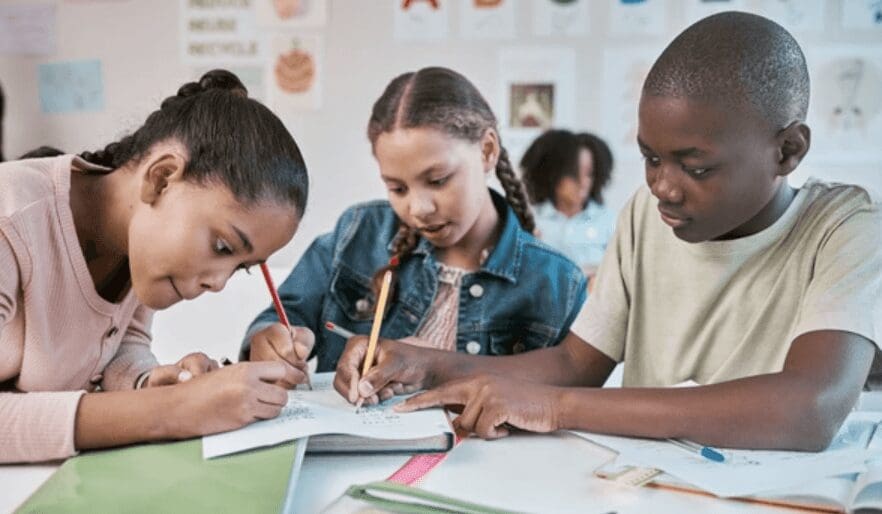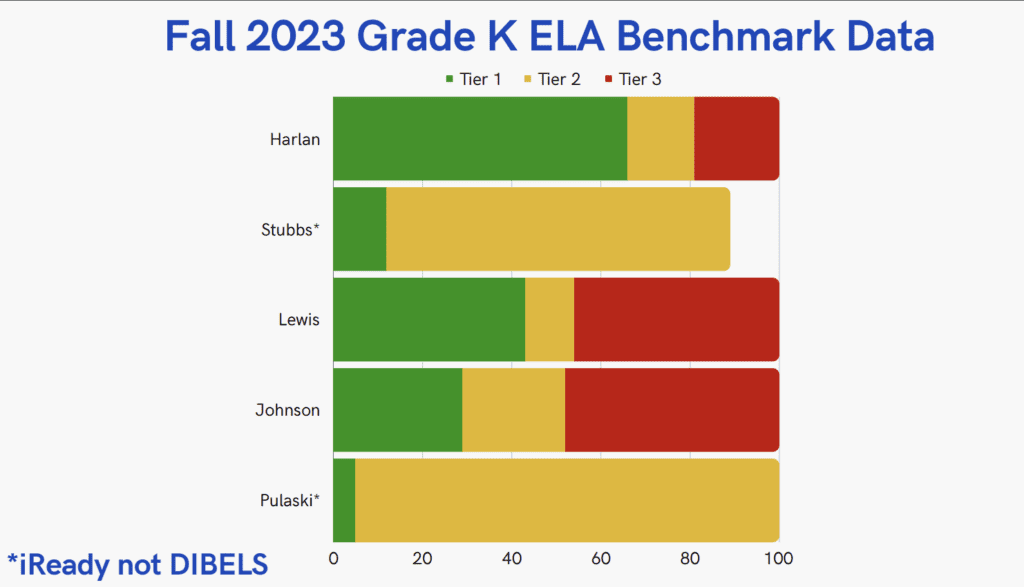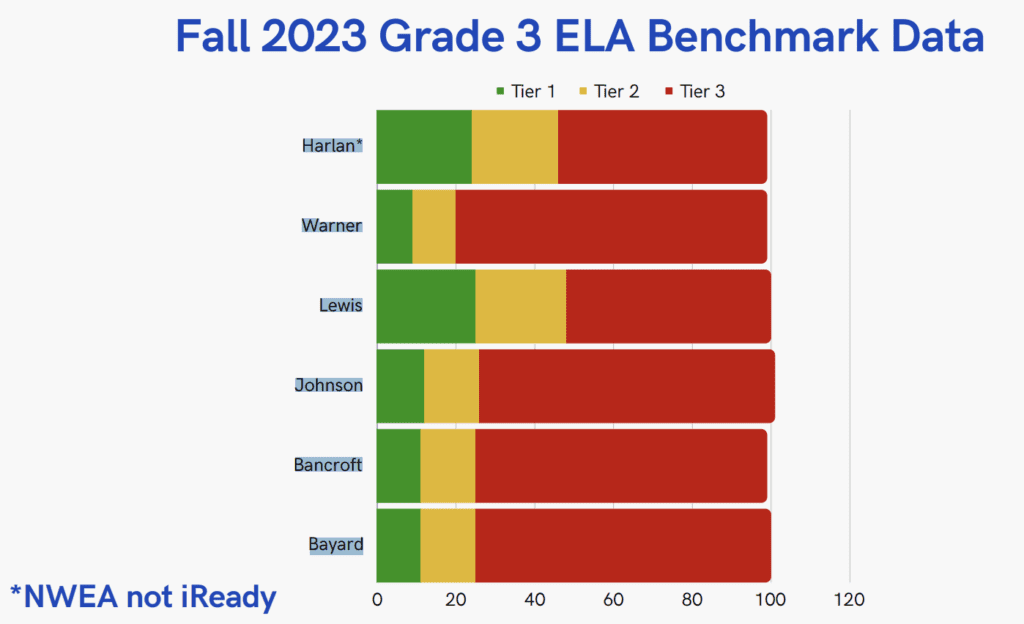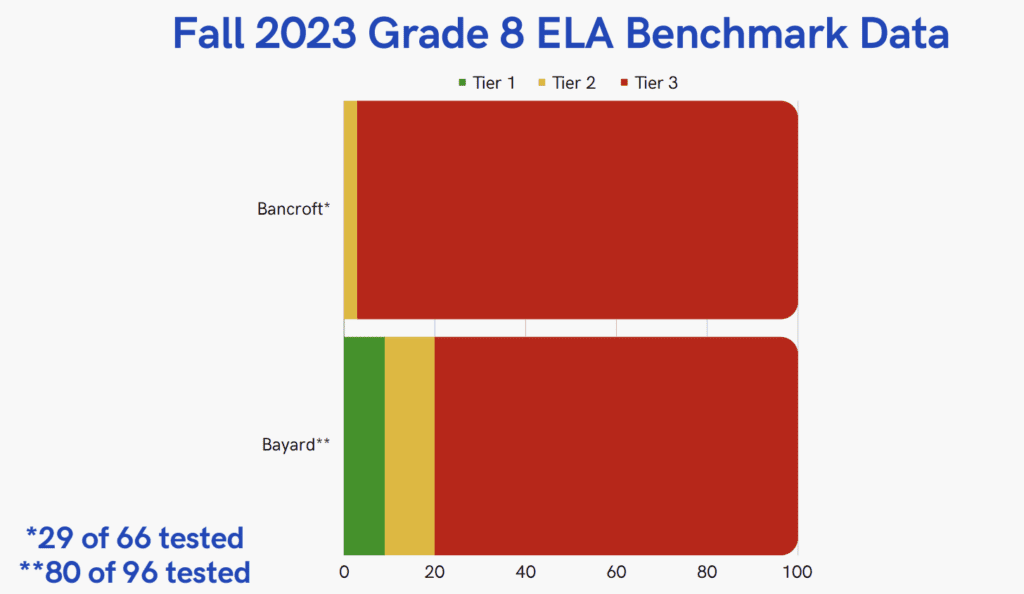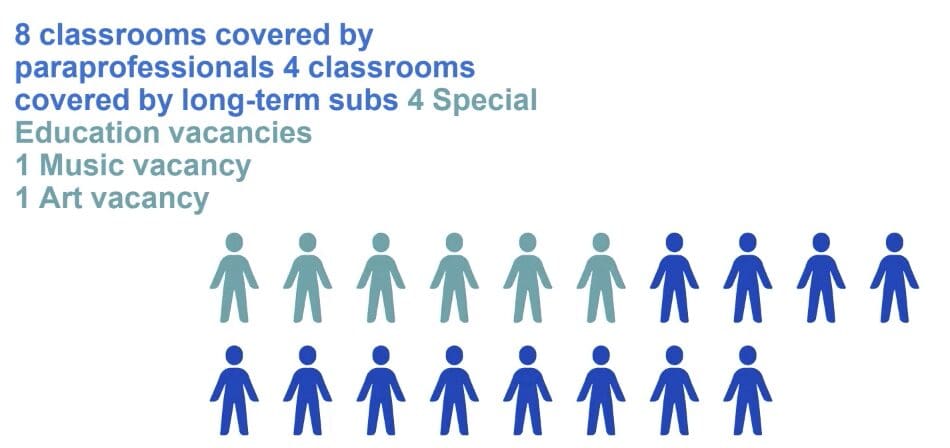Data on some of the high-needs and underperforming schools of the city of Wilmington was shared Wednesday night.
In the Red Clay Consolidated School District’s monthly board meeting, Laura Burgos, executive director of the Wilmington Learning Collaborative, presented assessment highlights on the nine schools involved in the agency.
The Wilmington Learning Collaborative, a state agency created in November 2022 with millions of dollars in funding, has the goal of improving educational and societal outcomes for children in nine city elementary schools across Brandywine, Red Clay and Christina school districts.
Burgos shared some English language arts testing data from the nine schools in the collaborative:
The green represents the percentage of students who are on grade-level. The yellow represents tier-two students who are a year below grade-level. The red represents tier-three students that are more than a year below grade-level.
Burgos pointed out how as students climb the ladder of grades, they seem to become less and less proficient, which is apparent when comparing the kindergarten data to grade three and grade eight data.
“So you see the dramatic shift, and when I look at this data, it’s clear that our students are entering our schools ready to learn,” she said, “and then we see what happens over time where we arrive at the eighth grade with students who are going to experience significant challenges making that transition to high school.”
This past month, all nine WLC schools completed site visits and are in the process of completing the final data submissions which includes student surveys, family and staff surveys and more.
RELATED: WLC hires 2, completes school assessments
The collaborative is in a foundational stage right now of assessing where each school is at and what each of their unique needs are, which will help shape how the agency implements programs in each.
RELATED: WLC gets another planning year after Brandywine vote
“One of the charges of the WLC was to conduct a landscape analysis across all nine of our schools, which is something that hasn’t been done before,” Burgos said. “We know there have been reviews by external partners in the past, but never have we looked across districts using the same lens using the same approach.”
She said the landscape analysis and diving into each school’s teaching and learning systems is seen as the “first phase” of the collaborative’s deeper analysis as it begins to interrogate those systems that need to be redefined in order to serve all students equitably.
“What this project entailed was a series of school visits, conversations with teachers, school leaders, visits to classrooms to really better understand our instructional practices,” she said. “In addition to examining student work products, student survey data, family survey data, we are concluding this project as of tomorrow, in which we will be submitting our final data points.”
Burgos also shared that eight of the nine schools have submitted Innovation Project proposals.
These proposals were submitted by educator leader teams, which each school has. They are a core team of educators that are charged with supporting and creating a space where decisions can be made for school-based change initiatives.
“We asked each team to think about a particular school outcome and their success plans that they’d like to shift in a new way,” Burgos said. “We asked them to be very creative. We encouraged risk taking. We gave them the charge proposing a new solution, and each school of course interpreted this very differently.”
The collaborative will run three cycles of these Innovation Projects throughout the school year.
“We’re excited to say that we received that first set of proposals this past Friday,” Burgos said. “We’ll be spending the next few weeks supporting our ELT teams and launching them and making sure they have the resources and funding necessary to do so.”
She also laid out the collaborative’s next steps.
“Over the next few months the team will analyze everything, and we will be dealing with a set of reports, opportunity scorecard reports,” she said. “We will receive a set for each individual school, which will be the first delivery of reports on February 23.
Then the collaborative will also receive individual district reports as well as one comprehensive WLC report.
“And this will be an important starting point,” she said. “What we expect to see are the highlighting those promising practices that are already in place that we can build upon and share across schools and school systems, but also a set of recommendations for how we can really focus our efforts.”
The collaborative’s initial assessment also found that just 45% of teachers in the nine WLC schools remain in the same school for three years.
“That affects everything,” she said. “That affects continuity programs and professional learning supports and building that strong community with families.”
She shared alarming staffing data for one anonymous school in the collaborative, which Red Clay Superintendent Dorrell Green pointed out was not a Red Clay school:
Burgos said this is an example of why there needs to be a focus on creating teacher pathways for students or prospective teachers.
Board member Cathy Thompson asked some brief clarifying questions about the signed memorandum of understanding, and then emphasized that she and the three districts need to continue to hold the collaborative accountable.
“We need to hold you accountable,” she said. “I know that you’re supposed to come back to us and we have to get an agreement on how we’re going to look at student improvement. So I assume by the end of sometime next year, I know you have to do it by March, but sometime next year, you’ll come back to us so that we have an input into looking at how the students are achieving.”
She said a challenge arises when schools and districts use different tests.
“I’m concerned about veering off of what we use because then I don’t know that we’ll have any baseline for looking at how the students are progressing,” Thompson said, “Because the idea obviously, is for you to improve the student outcomes which we very much hope you do.”
Burgos acknowledged that different tests, along with different curricula across districts, does create challenges.
It’s not solely about the tool you use, though, but the approach,” she said. “Having that deep-level content knowledge is the primary focus.”
Thompson expressed deep gratitude for Burgos coming to district meetings and presenting updates of the collaborative’s work.
“This is critical,” Thompson said. “These are some of our most vulnerable students, and so I know everybody has been very concerned about it.”

Raised in Doylestown, Pennsylvania, Jarek earned a B.A. in journalism and a B.A. in political science from Temple University in 2021. After running CNN’s Michael Smerconish’s YouTube channel, Jarek became a reporter for the Bucks County Herald before joining Delaware LIVE News.
Jarek can be reached by email at [email protected] or by phone at (215) 450-9982. Follow him on Twitter @jarekrutz
Share this Post


